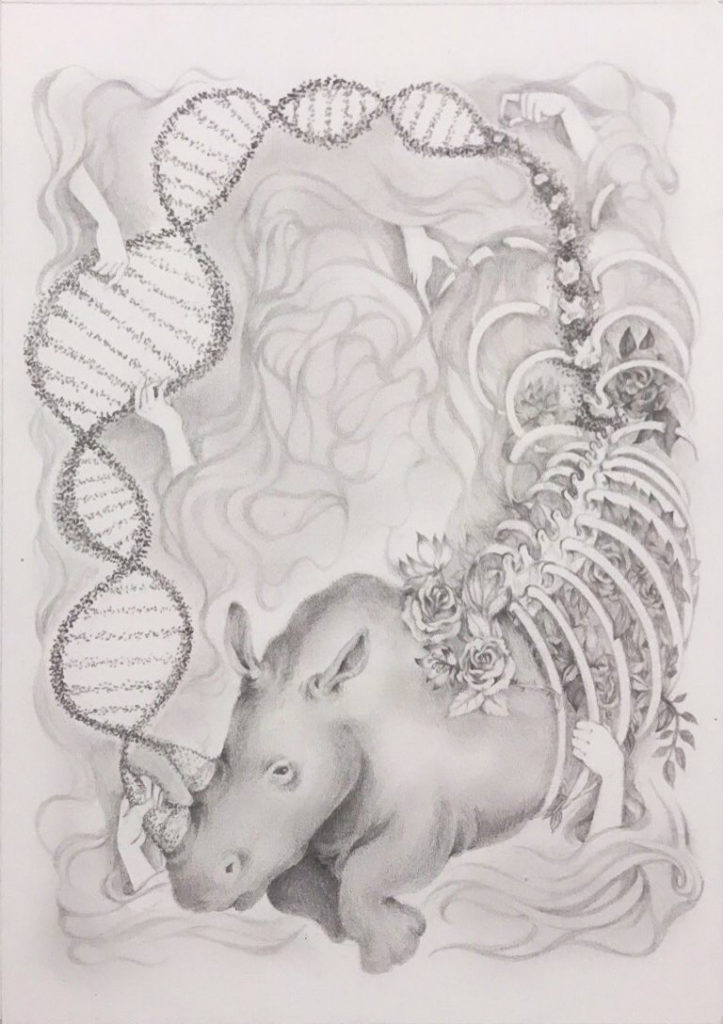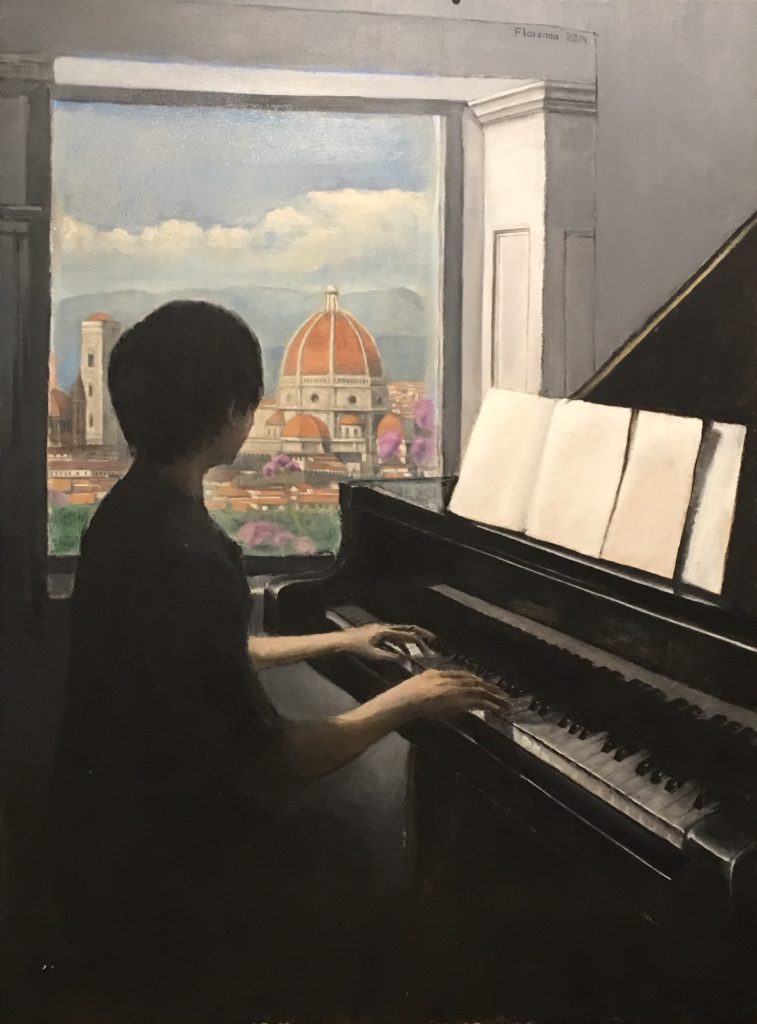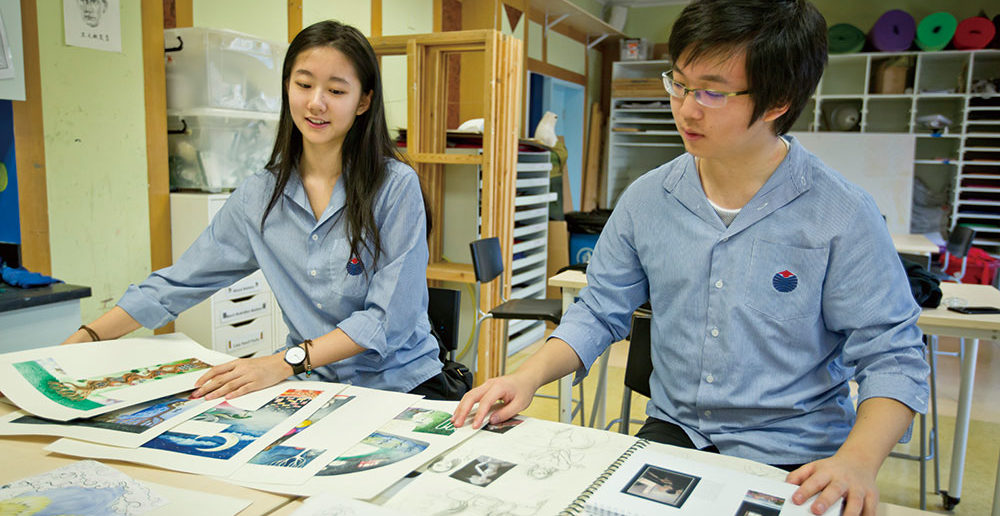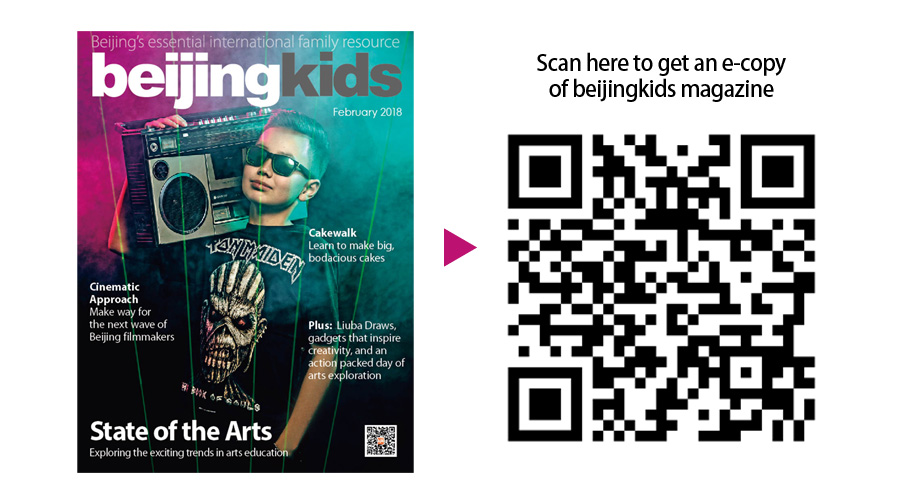Tests, deadlines, projects, and so on. And parental expectations. And academic pressure. And finding your voice. And the very strain of students’ life can be the fuel of their artistic expression.
Such is the case of Annie Ding, a Year 13 student at Yew Chung International School of Beijing (YCIS Beijing). She showed us her artworks, including her favorite: a painting of a two-headed girl. Ding said it reflects the loss of individuality of a student who has constantly faced expectations from parents and struggled to conform to societal norms.
“In a way, you can interpret [my artworks] as my escape from real life, I suppose. A lot of times, I indulge in things that don’t really exist in reality to alleviate the stress from my parents and education. Through that, I’m trying to show who I really am, what I’m really about,” she said.
Her classmates Echo Liu and Ian Zhao, though not exactly facing the same situation as Ding, also find in their struggles the inspiration for their creations, which they showcase in their portfolios.
Gathering this supporting information seems to be as difficult as finishing the artworks themselves.
Whereas it takes Zhao around two weeks to do a full oil painting on canvas, the documentation of all the required processes, mind maps, and research will take him up to six months. “I’m a classical person,” Zhao said, “I create art whenever I want. I don’t record my ideas that much, but it’s different for IB [the International Baccalaureate program]so this is a challenge to me.”


Though a portfolio is not a requirement for their grade under the IB arts program, their teacher Allison Cusato says making one will show their development, creativity, and voice as artists, especially now that they are applying to arts schools or universities in the US.
“Because the IB program is so specific and intensive, I require my students to stick to guidelines when developing their portfolio. Often their writing within the IB submission includes reflection on the challenges that the artist faced during the creative process. This is an important component because it shows that students are thinking about their process, and it shows how they approach creative problem solving,” Cusato explained.

The Rationale Behind Portfolios
It’s true that the process of compiling a student’s best pieces of work takes a considerable amount of time. For high-schoolers who will use their portfolios as a supplement to their university application, however, it is a taxing task given the pressures of other academic requisites. Sidney Hsu, CEO and co-founder of EXR International Art Center, a school that helps Chinese arts students prepare for arts school abroad, recommends that pupils should have a full understanding of the requirements of their prospective schools.
“Pay attention to the composition of the portfolio. If your rationale behind the artworks is clear, the admissions officer can understand you even if they are just looking at your work.”
Hsu says that art schools will look for students who can use their artworks to find a creative solution to everyday problems, and that “it will be a shining point in the students’ application.” But beyond the surface and meaning of the greatest and most creative works, it is the student’s individuality that will always stand out.
“A good portfolio has a certain ‘texture’ that reveals your personality or strong characteristic that you’ve nurtured up to this point in life,” says Kin Lam, director of Inkmason International, an interior design firm based in Beijing.
“Doing portfolios can be time-consuming, yet it practices one’s craftsmanship, helping you to be more precise and show how passionate you are about something,” Lam said, adding that students developing portfolios also need to show sincerity. “Your naivety will tell people about you… and that is more important than making your collection a ‘selling piece’ of yourself.”
Beijingkids gathered Ding, Liu, Cusato, and Lam for a group discussion to help the students prepare their portfolios for university application. We can only summarize the hour-long activity in a few paragraphs, but we thought that the insights which emerged would inspire other arts students in their preparation for college, internships, and future careers.
Cusato: When it comes to applying to colleges [for arts students], it’s important to go to specifications. Each college has its own way of asking and requesting for information to be sent and shown. If they want photographs of your artwork, it’s best to send them the way they requested them to be. But when it comes to looking for jobs or internship, then a website or digital artwork would be the best way. What would you be looking for at your end?
Lam: There are so many ways to showcase your work digitally. Online portfolios often have templates, and in a way, it is convenient for students. On the other hand, there are some limitations. Make sure your portfolio is readable and understandable. Then know how much you want to show your personality. Allison, you have the same experience when you were working in the US. I’m sure you’ve interviewed a lot of people and received a lot of CVs. One after another, they’re all the same. Sometimes, you want to see something that inspires you and I’m looking for that, especially when people are daring to show their work during school time. I’m excited to see that. But after they start working, the projects become all the same.
Cusato: When I go to interviews, I would carry around the portfolio that has not only my graphics works but also my personal artworks that I have created in my own time. A really well-packaged portfolio done in a unique way would be something that is always an eye-catcher or grab someone’s attention.
Ding: So far, the artworks I did for IB center on individuality, and just like Echo (Liu), we’re struggling with our personal identity in a society where our parents and teachers have a lot of expectations. These daily struggles inspire our creative works that speak out our issues and communicate our emotions without offending anyone. Kin, you mention that you enjoy seeing the naivety and ‘pureness’ in young people. A lot of time, kids our age and other college applicants will try to sell how mature we are, so that we become not ourselves anymore. My mother said that to stand out in college applications, you need to show that you are mature but you’re also a child at the same time. There are still some aspects of you that can inspire others. So I feel that what you said about naivety is important for me.
Liu: I chose the theme of individuality because I didn’t know what to do at first. But later on, I wanted to find myself. Individuality is related to myself, what my thoughts are, and those things that influence me. We went to the US for a summer program and that’s when I realized I wanted to do graphic design in college. I didn’t really like it at first, but the idea of working with others to create something is something I like. I want to work with people and see them use and appreciate my creations. You’re a designer so you understand the difference between graphic design and fine arts. I wonder, how did you know what you wanted to do?
Lam: When I first did photography, my mom said, “You cannot make a living with that.” I didn’t believe her; I’ve been doing it still and I thought, “How can I find something that will earn me a living and still do what I want to do?” A few years after, I realized I maybe I could do design and architecture even if I had no idea what it was then. The first design theory I learned from my professor was, “After you graduate, only 10 percent of your work will be enjoyable.” I thanked him for giving me a reality check. But when you know what your purpose is and hold on to that despite the struggles, whatever you do and create will be interpreted as your passion. You face struggles because you are trying to release yourself. The passion inside you is the true view of your creation.

Photos: Dave’s Studio, Uni You, Lens Studio; courtesy of YCIS Beijing
This article appeared on p50-53 of beijingkids February 2018 issue.